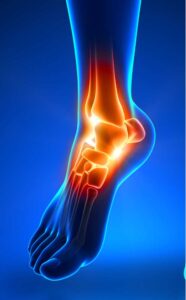Complex Ankle Specialists
Have you experienced a recent injury to the ankle from a fall, twist, or other high impact accident? If so, you may have experienced a tibial pilon fracture. A tibial pilon fracture is a breakage to the bottom portion of the tibia, or the shinbone. These injuries are often caused by snowboarding accidents and can result in pain, swelling, deformity to the ankle, and an inability to place weight on the foot. Doctors Thomas Haytmanek and Jonathon Backus can provide diagnosis and a specialized treatment plan for patients in Vail and Frisco, Colorado, as well as Denver, Boulder, and surrounding Summit County areas who have experienced a tibial pilon fracture. Contact The Steadman Clinic’s Sports Foot and Ankle team today!

What is a tibial pilon fracture?
A tibial pilon fracture is a break at the bottom or distal portion of the tibia, more commonly known as the shinbone. A tibial pilon fracture can be a result of impact from a fall, a twist, or a car accident. Typically, the fibula (the smaller ankle bone in the lower leg, parallel to the tibia) will also break when a tibial pilon fracture occurs. Tibial pilon fractures are less common than an ankle fracture which involves a rotational injury to the foot, breaking the fibula and / or tibia. A tibial pilon fracture involves the weight bearing portion of the distal tibia. Our physicians have extensive experience treating tibial pilon fractures, especially those caused by skiing and snowboarding injuries.

What are the symptoms of a tibial pilon fracture?
When the tibia bone breaks through the skin, the result is a compound or “open” fracture. Such an injury requires urgent surgery to correct. Frequently, an external fixation device is applied to help correct and stabilize the broken bones. The symptoms of a tibial pilon fracture or broken shinbone are:
- Pain, which can depend on the severity of the break
- Swelling
- Bruising
- Tenderness
- Deformity of the ankle
- Inability to bear weight on the affected foot or leg
How is a tibial pilon fracture diagnosed?
Our physicians will evaluate the area of injury and assess the swelling. The ankle is an area prone to significant swelling. An x-ray will be performed to show details of the injury and break. A CT scan may also be necessary to understand the severity of the break and to see fracture lines more clearly. The CT can also aid in preoperative planning, if surgery is needed. If an external fixation device was applied, definitive surgical fixation typically takes place in 1-2 weeks, once the swelling has begun to subside.
How are tibial pilon fractures treated?
Non-Surgical Treatment
In the event the tibia is still in place or is still properly aligned and the bone is parallel to the fibula, surgery may not be necessary. Our physicians may apply a splint or cast to the lower leg to hold the fracture in place. A walking boot may be fitted, or a cast, after the swelling subsides. Healing can take approximately twelve weeks.
Surgical Treatment
If the tibia is not in its proper place, surgery may be recommended. Our physicians will evaluate the swelling and make a recommendation about surgery once the swelling has decreased. During surgery, our physicians will reposition (reduce) the displaced bone and bone fragments to their original form; internal fixation (rods, plates and screws) will be utilized to hold the fractures in place until they heal. This is called open reduction internal fixation, or ORIF. If an external fixation device was used, this is typically removed during the surgery. The correction may be done in one or two surgeries depending on the severity of the break. Typically, we prescribe a blood thinner to prevent blood clots in the leg during recovery.
What is the recovery after tibial pilon fracture surgery?
Patients are generally kept non-weight bearing for the first six weeks. Weeks 6-12 involve a weight bearing progression in a CAM boot. This is typically followed by a CAM boot weaning process (removing the boot for 1 hour in the morning, then one hour in the afternoon, and a few days later working up to 2 hours at a time, etc.). Physical therapy is an integral part of full recovery.
Full recovery (return to all activities) typically takes 3-6 months.
For more information on tibial pilon fractures please contact the office of Sports Foot and Ankle, Orthopedic Foot and Ankle Specialists serving Vail, Colorado and the surrounding Eagle, Vail Mountain Range Community.
